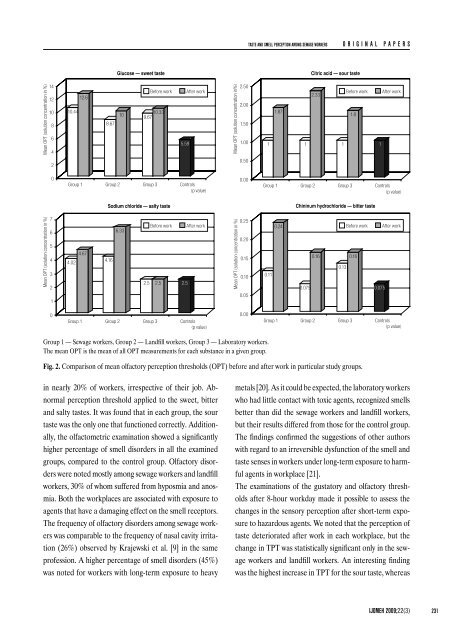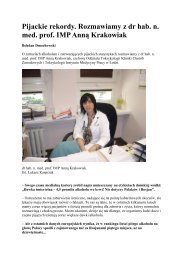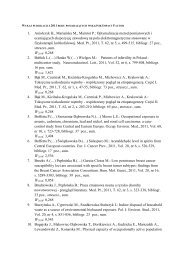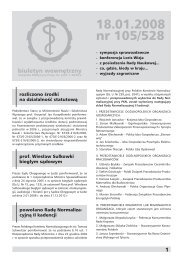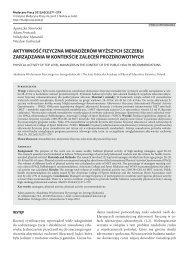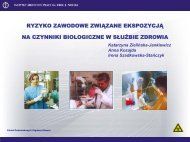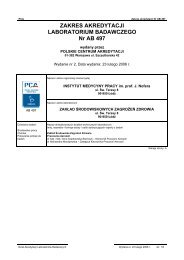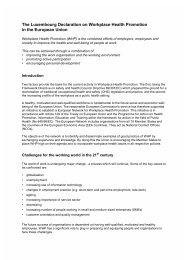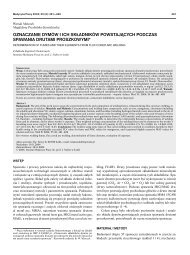taste and smell perception among sewage treatment and landfill ...
taste and smell perception among sewage treatment and landfill ...
taste and smell perception among sewage treatment and landfill ...
Create successful ePaper yourself
Turn your PDF publications into a flip-book with our unique Google optimized e-Paper software.
TASTE AND SMELL PERCEPTION AMONG SEWAGE WORKERSORIGINAL PAPERSGroup 1 — Sewage workers, Group 2 — L<strong>and</strong>fill workers, Group 3 — Laboratory workers.The mean OPT is the mean of all OPT measurements for each substance in a given group.Fig. 2. Comparison of mean olfactory <strong>perception</strong> thresholds (OPT) before <strong>and</strong> after work in particular study groups.in nearly 20% of workers, irrespective of their job. Abnormal<strong>perception</strong> threshold applied to the sweet, bitter<strong>and</strong> salty <strong>taste</strong>s. It was found that in each group, the sour<strong>taste</strong> was the only one that functioned correctly. Additionally,the olfactometric examination showed a significantlyhigher percentage of <strong>smell</strong> disorders in all the examinedgroups, compared to the control group. Olfactory disorderswere noted mostly <strong>among</strong> <strong>sewage</strong> workers <strong>and</strong> l<strong>and</strong>fillworkers, 30% of whom suffered from hyposmia <strong>and</strong> anosmia.Both the workplaces are associated with exposure toagents that have a damaging effect on the <strong>smell</strong> receptors.The frequency of olfactory disorders <strong>among</strong> <strong>sewage</strong> workerswas comparable to the frequency of nasal cavity irritation(26%) observed by Krajewski et al. [9] in the sameprofession. A higher percentage of <strong>smell</strong> disorders (45%)was noted for workers with long-term exposure to heavymetals [20]. As it could be expected, the laboratory workerswho had little contact with toxic agents, recognized <strong>smell</strong>sbetter than did the <strong>sewage</strong> workers <strong>and</strong> l<strong>and</strong>fill workers,but their results differed from those for the control group.The findings confirmed the suggestions of other authorswith regard to an irreversible dysfunction of the <strong>smell</strong> <strong>and</strong><strong>taste</strong> senses in workers under long-term exposure to harmfulagents in workplace [21].The examinations of the gustatory <strong>and</strong> olfactory thresholdsafter 8-hour workday made it possible to assess thechanges in the sensory <strong>perception</strong> after short-term exposureto hazardous agents. We noted that the <strong>perception</strong> of<strong>taste</strong> deteriorated after work in each workplace, but thechange in TPT was statistically significant only in the <strong>sewage</strong>workers <strong>and</strong> l<strong>and</strong>fill workers. An interesting findingwas the highest increase in TPT for the sour <strong>taste</strong>, whereasIJOMEH 2009;22(3) 231


